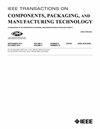Printed Circuit Board (PCB)-Integrated Millimeter Module Composed of a Horn Antenna Fed Through a Grounded Coplanar Waveguide
IF 3
3区 工程技术
Q2 ENGINEERING, ELECTRICAL & ELECTRONIC
IEEE Transactions on Components, Packaging and Manufacturing Technology
Pub Date : 2025-04-03
DOI:10.1109/TCPMT.2025.3557708
引用次数: 0
Abstract
This article details the design and manufacturing process of a compact module fed through a transition between a grounded coplanar waveguide (GCPW) input line and an air-filled (AF) waveguide integrated into the substrate. This waveguide feeds a micromachined horn antenna. The developed technology is based on the micromachining of an AF waveguide on a first substrate and a horn antenna on a second one. These two substrates are then assembled by a thermal diffusion process, which allows for creating an electrically conductive bonding interface. The novelty of this work relies in the use of this innovative technological process for the realization of millimeter-wave (mm-wave) subsystems. Furthermore, the developed technology enables the creation of high-performance components utilizing AF substrate integrated waveguides (AF-SIWs). This approach effectively addresses the challenges associated with transferring, integrating, and reducing costs often encountered in high-frequency systems development. The resulting device forms a highly integrated, low-cost, yet electrically performant mm-wave module entirely manufactured with a printed circuit board (PCB) process. The manufactured prototype operates at V-band, exhibiting a bandwidth of 3.1% and a maximum gain of 6.4 dBi.印刷电路板(PCB)-集成毫米模块,由喇叭天线组成,通过接地共面波导馈电
本文详细介绍了一种紧凑模块的设计和制造过程,该模块通过接地共面波导(GCPW)输入线和集成在基板中的充气(AF)波导之间的过渡来馈电。这个波导为一个微机械喇叭天线供电。所开发的技术是基于在第一基片上的自动对焦波导和在第二基片上的喇叭天线的微加工。然后通过热扩散过程组装这两个衬底,从而可以创建导电粘合界面。这项工作的新颖性在于使用这种创新的技术过程来实现毫米波(mm-wave)子系统。此外,开发的技术能够利用AF基板集成波导(AF- siws)创建高性能组件。这种方法有效地解决了与高频系统开发中经常遇到的转移、集成和降低成本相关的挑战。由此产生的器件形成了一个高度集成、低成本、但性能良好的毫米波模块,完全由印刷电路板(PCB)工艺制造。该样机工作在v波段,带宽为3.1%,最大增益为6.4 dBi。
本文章由计算机程序翻译,如有差异,请以英文原文为准。
求助全文
约1分钟内获得全文
求助全文
来源期刊

IEEE Transactions on Components, Packaging and Manufacturing Technology
ENGINEERING, MANUFACTURING-ENGINEERING, ELECTRICAL & ELECTRONIC
CiteScore
4.70
自引率
13.60%
发文量
203
审稿时长
3 months
期刊介绍:
IEEE Transactions on Components, Packaging, and Manufacturing Technology publishes research and application articles on modeling, design, building blocks, technical infrastructure, and analysis underpinning electronic, photonic and MEMS packaging, in addition to new developments in passive components, electrical contacts and connectors, thermal management, and device reliability; as well as the manufacture of electronics parts and assemblies, with broad coverage of design, factory modeling, assembly methods, quality, product robustness, and design-for-environment.
 求助内容:
求助内容: 应助结果提醒方式:
应助结果提醒方式:


